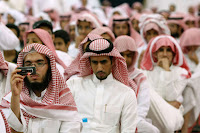 Arab News recently carried an essay translated from the local press. The writer, Ali Al-Mosa reports, "Saudis top the entire world in the consumtion of tea and coffee. They also top the world in the consumption of Viagra, spending about SR 150 million on it annually."
Arab News recently carried an essay translated from the local press. The writer, Ali Al-Mosa reports, "Saudis top the entire world in the consumtion of tea and coffee. They also top the world in the consumption of Viagra, spending about SR 150 million on it annually."It appears, though it is not clearly stated, that the top rank secured by the Saudis is in terms of total, not per capita, consumption. That is really hard to believe. With only some 25 million people, including expatriates, try to imagine how much tea or coffee each Saudi would have to consume to beat, say, the 1.3 billion Chinese. With a large majority of the population under the age of 30 and with so little opportunities/inclination to be promiscuous, it is hard to understand why Saudi men would have such a need for Viagra pills.
But then the title of the story was 'Unreliable consumer statistics', and the 'facts' were cited to drive home the point that consumer statistics published in the local press need to be taken with a grain of salt.
However, if the press reports that the Saudis top the world in consumption of white cloth, I, for one, would be inclined to believe it. Except for the very brief period of the year that can be termed winter, Saudi men are always clad in ankle-length white robes, with white undergarments underneath, and around may be half of them sport a headgear made of a large white scarf-life piece of cloth (the rest wear a red-and-white pattern).
Photo credit: Hassan Ammar/AP